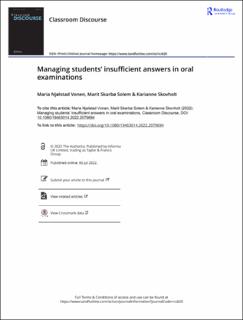| dc.contributor.author | Vonen, Maria Njølstad | |
| dc.contributor.author | Solem, Marit Skarbø | |
| dc.contributor.author | Skovholt, Karianne | |
| dc.date.accessioned | 2022-07-22T11:07:14Z | |
| dc.date.available | 2022-07-22T11:07:14Z | |
| dc.date.created | 2022-07-07T09:42:58Z | |
| dc.date.issued | 2022 | |
| dc.identifier.citation | Vonen, M. N., Solem, M. S. & Skovholt, K. (2022). Managing students’ insufficient answers in oral examinations. Classroom Discourse, 1-23. | en_US |
| dc.identifier.issn | 1946-3014 | |
| dc.identifier.uri | https://hdl.handle.net/11250/3007796 | |
| dc.description.abstract | What happens when students cannot answer teachers’ questions in oral examinations? This study investigates how teachers manage students’ insufficient answers in disciplinary oral competence exams (DOCEs) in the secondary school context. Using conversation analysis, we show that teachers either pursue an answer by reformulating it and providing more topic information or abandon the original question and move on to a new sequence by creating contiguity and defusing negative implications. Pursuing provides additional opportunities to answer but does not necessarily enable students to provide quality answers. Abandoning means that students lose a chance to display knowledge, but it does provide an opportunity to answer another question. The study contributes to the understanding of managing trouble displays in non-standardized test talk and specifies interactional practices used to manage insufficient responses. It also reveals the dilemmas that teachers must solve in real-time examinations. | en_US |
| dc.language.iso | eng | en_US |
| dc.publisher | Taylor & Francis Group. | en_US |
| dc.rights | Attribution-NonCommercial-NoDerivatives 4.0 Internasjonal | * |
| dc.rights.uri | http://creativecommons.org/licenses/by-nc-nd/4.0/deed.no | * |
| dc.title | Managing students’ insufficient answers in oral examinations | en_US |
| dc.type | Peer reviewed | en_US |
| dc.type | Journal article | en_US |
| dc.description.version | publishedVersion | en_US |
| dc.rights.holder | © 2022 The Author(s). | en_US |
| dc.source.pagenumber | 1-23 | en_US |
| dc.source.volume | n/a | en_US |
| dc.source.journal | Classroom Discourse | en_US |
| dc.source.issue | n/a | en_US |
| dc.identifier.doi | https://doi.org/10.1080/19463014.2022.2079694 | |
| dc.identifier.cristin | 2037506 | |
| dc.relation.project | Norges forskningsråd: 273417 | en_US |
| cristin.ispublished | true | |
| cristin.fulltext | original | |
| cristin.qualitycode | 1 | |

